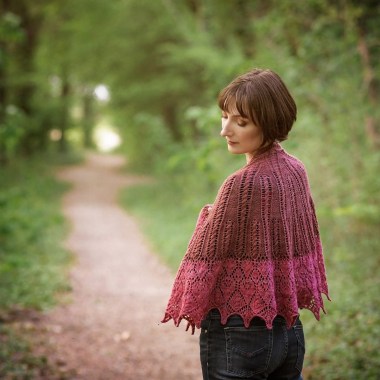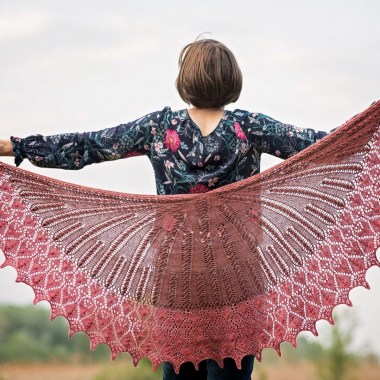Hopes and Dreams
Hopes and Dreams is a top-down crescent shawl that will make you fall in love with it immediately if you like cable and lace patterns. The body of the shawl features cables framed with eyelets, stretching towards the border like the rays of the sun. The border of the shawl was a “design-as-you-go” project, a method Agnes says her best shawl patterns are made with. How does this method work? Instead of experimenting on swatches, she works on the shawl itself from the beginning, because she says seeing the work in progress develop is a powerful source of inspiration. Only a couple of rows are charted out at once (sometimes as few as just 4, usually a bit more but not more than 20) and the chart goes into action immediately. This might be risky and result in some big-time ripping out, yes, but on the other hand, it can result in unique and original combinations.
The shawl can be worked in two colours as shown, just one, or a gradient. We suggest using solid or semi-solid yarns. Variegated yarns might steal the show and you won’t be able to see the pattern clearly.
YARN
Hopj’arn Merino Single
100% merino wool
400 meters (437 yards) / 100 grams
Colour 1 (C1) Wandering Thoughts 1 skein
Colour 2 (C2) Bouquet 1 skein
NEEDLE
4 mm (US 6) circular needle, 100 cm (40 inches)
or the needle size you need to get gauge
NOTIONS
blocking wire (optional)
stitch markers (optional)
blocking pins
SIZE
162 x 57 cm
162 x 57 cm63¾ x 22½ inches
GAUGE
20 stitches / 26 rows = 10 cm (4 inches) in pattern measured on the blocked shawl.
Pattern to swatch: Rows 9-12 of Chart E (repeat these 4 rows).
It is very important to block your swatch the way you will block your shawl (more aggressively than you normally would).Obtaining the gauge given is not crucial for a successful project, but will affect the finished size and the yardage needed.
NOTES ON YARDAGE
- The test knitters of this shawl used between 650 and 950 meters for this shawl. That is a huuuuge difference between the lowest and highest number, and that difference is made solely by GAUGE. If you have knitted a shawl before, you know getting gauge isn’t crucial BUT it will affect the size of your shawl and the yardage needed. You don’t have to swatch if you don’t mind how big your shawl is going to be or how much yarn you are going to use. However, if those things do matter, please do swatch.
- How to swatch for a shawl? It’s very important to BLOCK your swatch. Not just wash and lay flat to dry. Pull and pin. You have to block your swatch relatively aggressively to get reliable results. If you don’t do so, you will end up using much more yarn as the pattern says.
- The sample shawl used up almost all 400 meters from both skeins. If you want to be 100% sure that you will have enough yarn, go for a slightly tighter gauge than given in the pattern.
- If you think you will run out of Color 1 before you finish the body of the shawl, that’s no big deal, just work fewer repeats of Rows 9-12 of Chart E than given. However, be aware that if you have ran out of Color 1, you won’t have enough yarn of Color 2 either because you will need roughly the same amount. If you run out of Color 2 just before the bind-off, you can work the last two rounds and the bind-off or even just the bind-off in a third color. Two testers did that and it looks great, you can consider this option even if you don’t run out.










